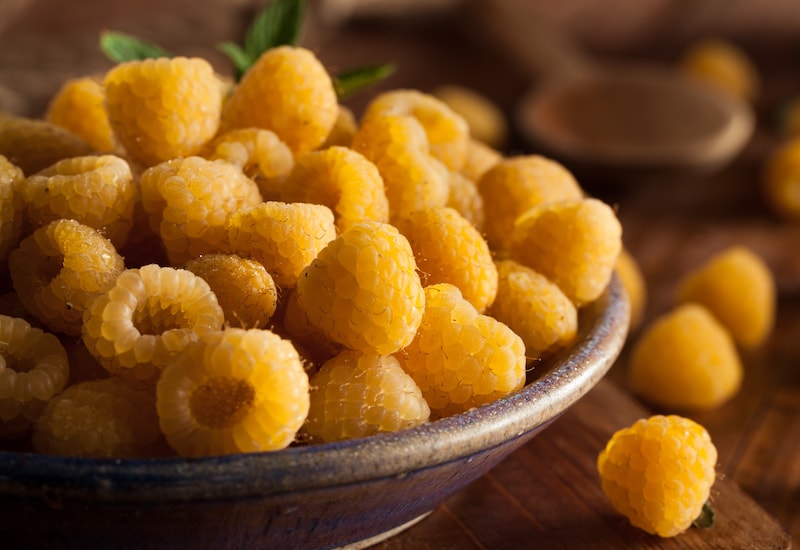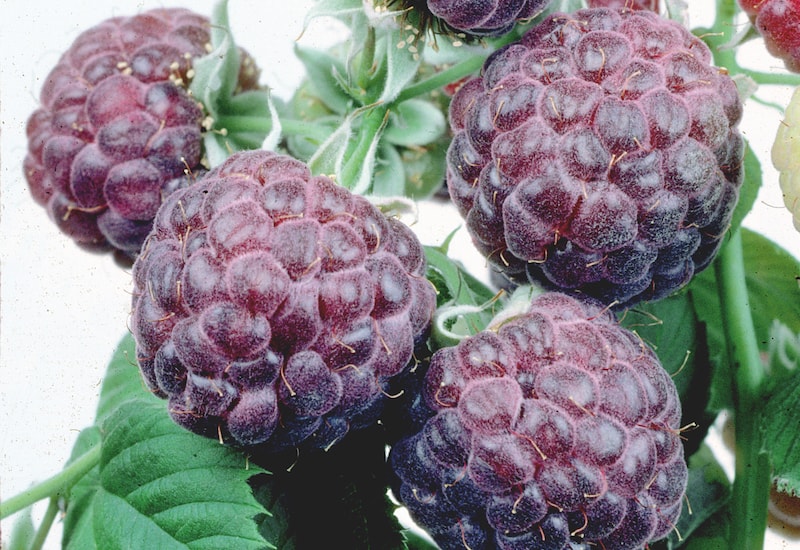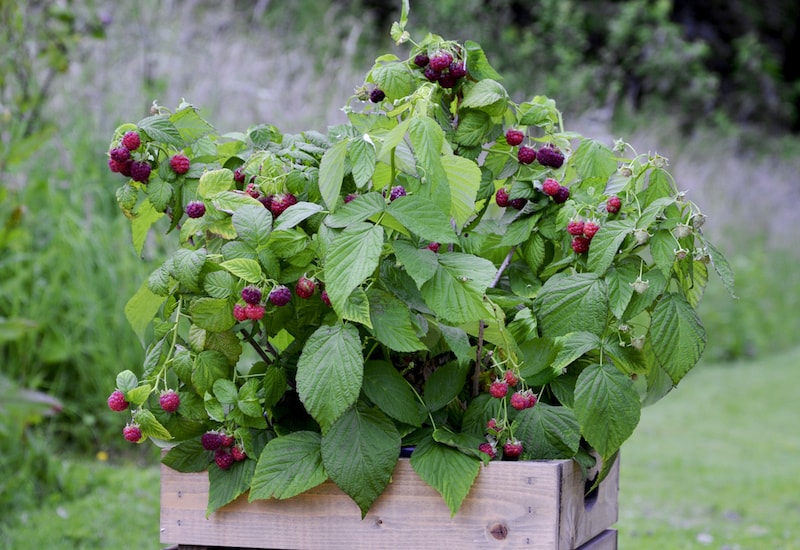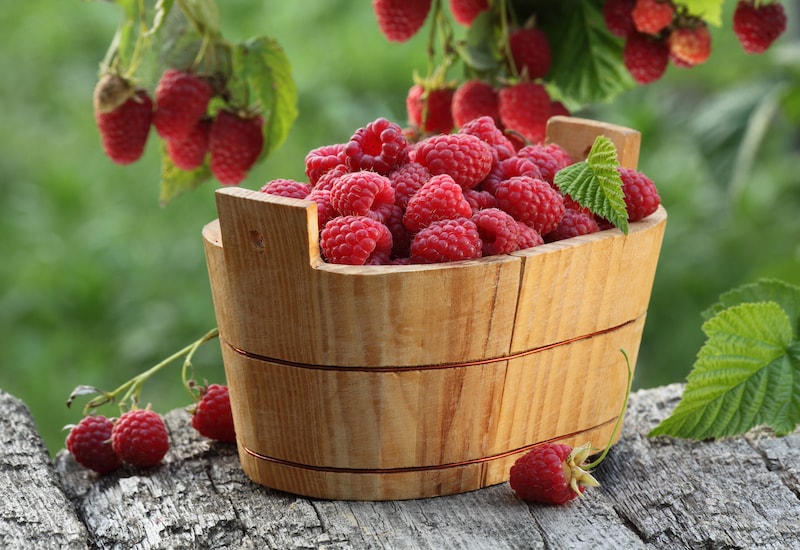Want expert tips on how to grow a bumper crop of raspberries? This collection of independent articles, Insta posts and YouTube videos is packed with advice from experienced raspberry growers who really know their stuff.
Why pay for tiny supermarket punnets when you can pick fresh fruit from your own garden? With a choice of summer and autumn-fruiting varieties, you’ll be harvesting delicious fruit for months on end. Browse our full range of raspberry canes for inspiration.
Contents:
- Best advice on summer-fruiting raspberries
- Best advice on autumn-fruiting raspberries
- Best advice on how to plant raspberries
- Best advice on pruning raspberries
- Best advice on caring for your raspberries
Best advice on summer-fruiting raspberries

Summer-fruiting ‘Glen Ample’ is a prolific cropper that’s easy to grow and care for
Image: Raspberry ‘Glen Ample’ from Suttons
There are two types of raspberry canes, explains Georgina Starmer in her comprehensive article over at Let’s Grow Wild. Floricanes usually produce fruit in the summer, while primocanes mainly fruit in the autumn. If you choose to plant floricanes like ‘Glen Ample’ and ‘Tulameen’ for an earlier crop, bear in mind that “summer-fruiting raspberries tend to grow tall, and will need supporting.” Read her full article for lots more tips.
“Popular summer-fruiting raspberry varieties like ‘Glen Ample’ and ‘Glen Prosen’ grow to a height of around 1.8 metres (6′) or more,” explains the Suttons horticultural team, and the simplest way to support your canes is by using horizontal wires against a wall, fence or garden shed. But, if you have lots of space, they say that the best way to plant raspberries is in open rows that run north to south, as this allows maximum sunlight to reach your fruits. Pick up more tips on how to grow and care for summer-fruiting raspberries over on the Suttons blog.
Experienced raspberry-grower Pumpkin Beth says that the summer-fruiting Raspberry ‘Glen Coe’ is her absolute favourite. She loves its “intense flavour,” and describes it as “tangy and very juicy with hints of apple, blackberry, and cherry.” This variety is good for bumper crops, even during very dry summers. Read her article for more raspberry variety recommendations and growing advice.
Best advice on autumn-fruiting raspberries

This golden-yellow raspberry variety is sweet and delicious
Image: Raspberry ‘All Gold’ from Suttons
While autumn-fruiting raspberry varieties aren’t as prolific as summer-fruiting types, they produce fruit on the current year’s growth so you’ll harvest your first raspberries much sooner. The horticultural team at Suttons recommends planting your autumn-fruiting raspberries further apart than the summer-fruiting varieties “to allow room for the development of more canes per plant”. For more expert advice on how to grow autumn-fruiting raspberries, visit the Suttons blog.
Over at The Garden of Eaden, Simon says, “you can’t beat the flavour of homegrown raspberries. And to be fair, they’re so easy to grow, and so expensive in the supermarkets.” In his hugely informative article, Simon suggests that beginners start with autumn-fruiting varieties which can be grown in the ground or containers. The reliable ‘Autumn Bliss’ is his top recommendation, but “for something more unusual try growing yellow raspberries such as ‘All Gold’.”
‘Autumn Bliss’ has also found a fan in Yorkshire-based gardener Craig, who relishes the fresh fruits as “a welcome snack when working the plot in the autumn sunshine”. Proudly showing his crop of autumn raspberries on his Instagram account @craig_grows_veg, he wants to add even more canes. Follow him to find out what other delicious fruit and veg he’s growing!
Best advice on how to plant raspberries

Summer-fruiting Raspberry ‘Glen Coe’ produces intensely-flavoured, purple fruits
Image: Raspberry Plants ‘Glen Coe’ from Suttons
Adam at Allotment Grow How planted his ‘Autumn Bliss’ raspberry bushes a little later than planned, but with good reason. He explained that, “because the weather was so, so wet, I couldn’t risk it…Raspberries don’t like very wet soil, they like it kind of free-draining.” Watch his easy-to-follow video for clear instructions on how to plant raspberry bushes.
If you want to build a support frame for your raspberry bed, watch Tanya Anderson’s excellent video over at Lovely Greens. Without one, she says that her raspberries would be “flattened by summer storms” up on her rather exposed allotment. Tanya’s video makes the process look quick and easy, and she helpfully includes a shopping list of the materials and equipment you’ll need. Looking for a clever way to use your pruned raspberry canes? In another short video Tanya demonstrates how to weave them into attractive garden edging.
If you want to grow raspberries in patio containers, John Moore of Pyracantha recommends choosing varieties that don’t grow too tall and that need less support. He also says that you should find large containers, as “raspberries tend to have long roots and need deep pots.” Want to learn John’s secret for making raspberries last longer once picked? Read his article…
Over at MandyCanUDigIt, gardener and journalist Mandy Watson grows her raspberries in raised beds to help contain the suckers. Why? If you don’t keep an eye on them, she explains that “the canes can spread like wildfire.” If you don’t have space to grow lots of soft fruit, read Mandy’s tips for double-cropping autumn-fruiting raspberries. Clever pruning can trick some of the canes into producing an early crop of berries in summer as well as later in the autumn. It’s the ideal solution for small gardens.
Best advice on pruning raspberries

Pruning your raspberries encourages healthy growth and bumper crops
Image: Raspberry ‘Malling Minerva’ from Suttons
Gary of The Allotment Garden & Kitchen prunes his summer-fruiting raspberries in mid-February, cutting back all the canes that produced last year’s fruit. In his helpful raspberry video, he clearly demonstrates how to tell which canes to cut back and which need to be left to produce this season’s fruit. Watch his full video on YouTube to pick up more tips on how to prep your raspberry patch for the year ahead.
For autumn-fruiting raspberries, pruning is even more simple, explains Justine from @rosemarycottagehookngsgarden. Because autumn-fruiting raspberries flower and fruit on new growth, you simply prune the whole lot down to the ground when they’re finished. Towards the end of the season, Justine tends to pick and prune her canes one at a time. As each cane finishes, she removes the final fruits and cuts it back hard straight away. And nothing goes to waste in this garden. The spent canes are piled up, “making a lovely wild twiggy area for hedgehogs to hibernate undisturbed.”
YouTube gardener Tony C Smith prunes all his autumn-fruiting raspberries in February, not forgetting those grown in containers. “Cut them right back to ground level,” he explains in his step-by-step video guide to growing raspberries. But the real secret to success is his homemade feed mix. Straight after pruning, sprinkle a good layer of chicken pellets along with blood, fish and bone over the entire bed. Apply a mulch, and your new autumn-fruiting canes will grow thick and strong.
Best advice on caring for your raspberries

Some varieties, like Raspberry ‘Yummy’, are compact and well-suited to growing in containers
Image: ©Branded Garden Products
Raspberry plants can be susceptible to certain pests and diseases, but don’t let that put you off – John Harrison of Allotment & Gardens has the solution! His comprehensive guide to common raspberry problems clearly explains how to spot, treat and prevent issues. Looking for an organic way to get rid of raspberry beetles? John recommends “hoeing in spring and summer [to] bring pupae to the surface and expose them to the birds and other predators”.
London-based gardener and self-confessed insect enthusiast, Phoebe, has discovered spotted wing drosophila in her raspberries. These pests have “a bad reputation for utilising ripening soft fruits to raise their young, rather than decaying fruit like other fruit flies”. Phoebe harvests her raspberries as soon as they’re ripe enough to pick, in an attempt to get to the fruit first. Follow her over at @shegrowsawildgarden to see her gorgeous photos.
Instagram gardener @patsy_smiles is hoping for a good harvest from her raspberry canes this year, as they “have leaves and most are now much taller than last year”. She grows her raspberries and currant bushes in a homemade fruit cage to protect the fruits from pests. Scroll through the images in her post to see her fruit cage and super “posh labels”.
Garden writer Rob Smith cleverly upcycled some runner bean supports to make his slimline, space-saving fruit cage over at @robsallotment. Keeping his summer and autumn raspberries safe from blackbirds and pigeons, check out his Insta post if you’re looking for a clever way to keep birds off your berries! The secret to securing the netting can be found in the comments!
We hope our fruit-growing experts have given you an appetite for growing your own raspberries. Whether you’re eating sun-warmed summer or autumn varieties straight from the garden, there’s no denying that homegrown raspberries are more delicious than anything you can buy in the shops!
Lead image: Raspberry ‘Joan J’ from Suttons
Last Updated on December 23, 2025 by Suttons Horticultural Team





